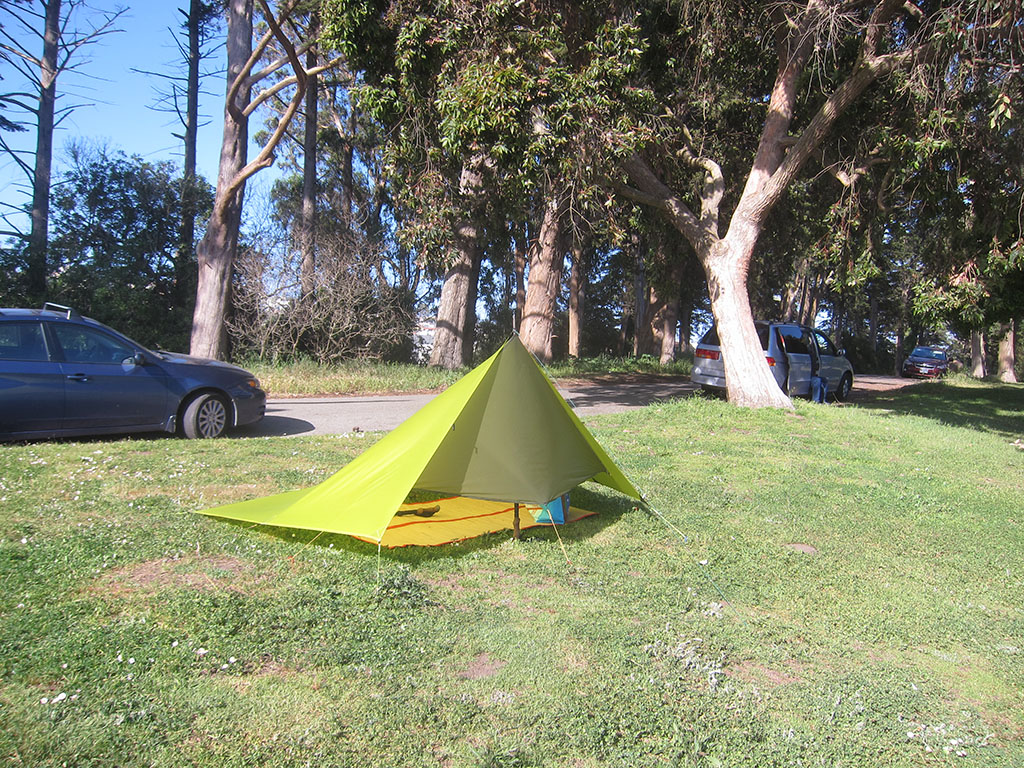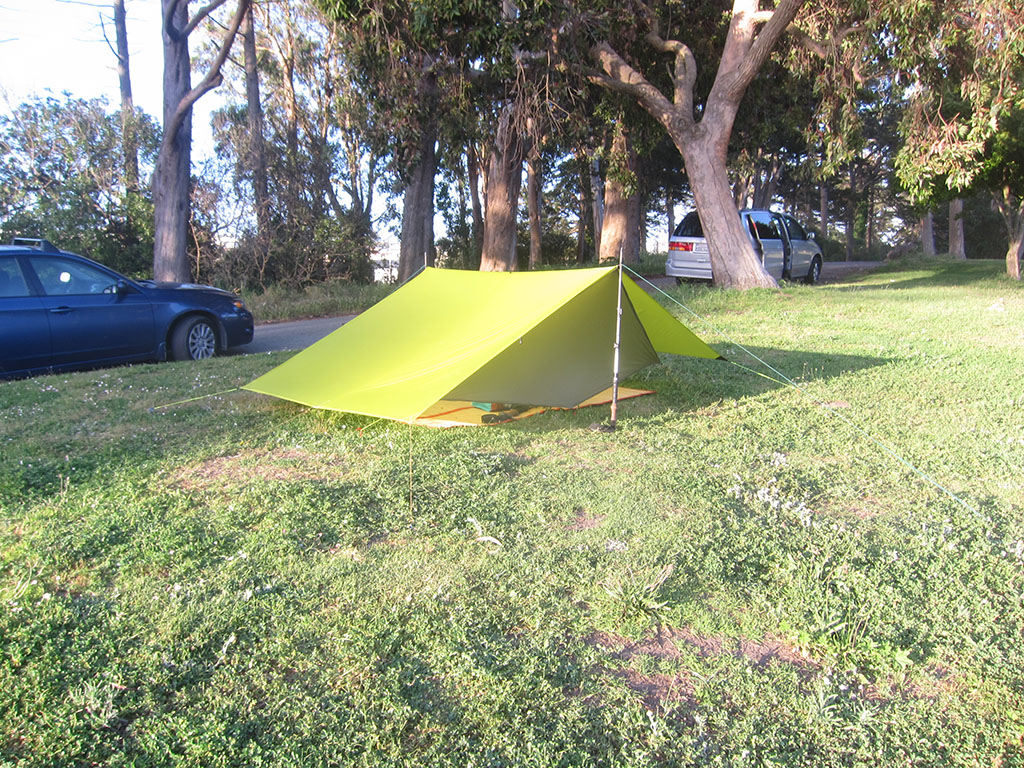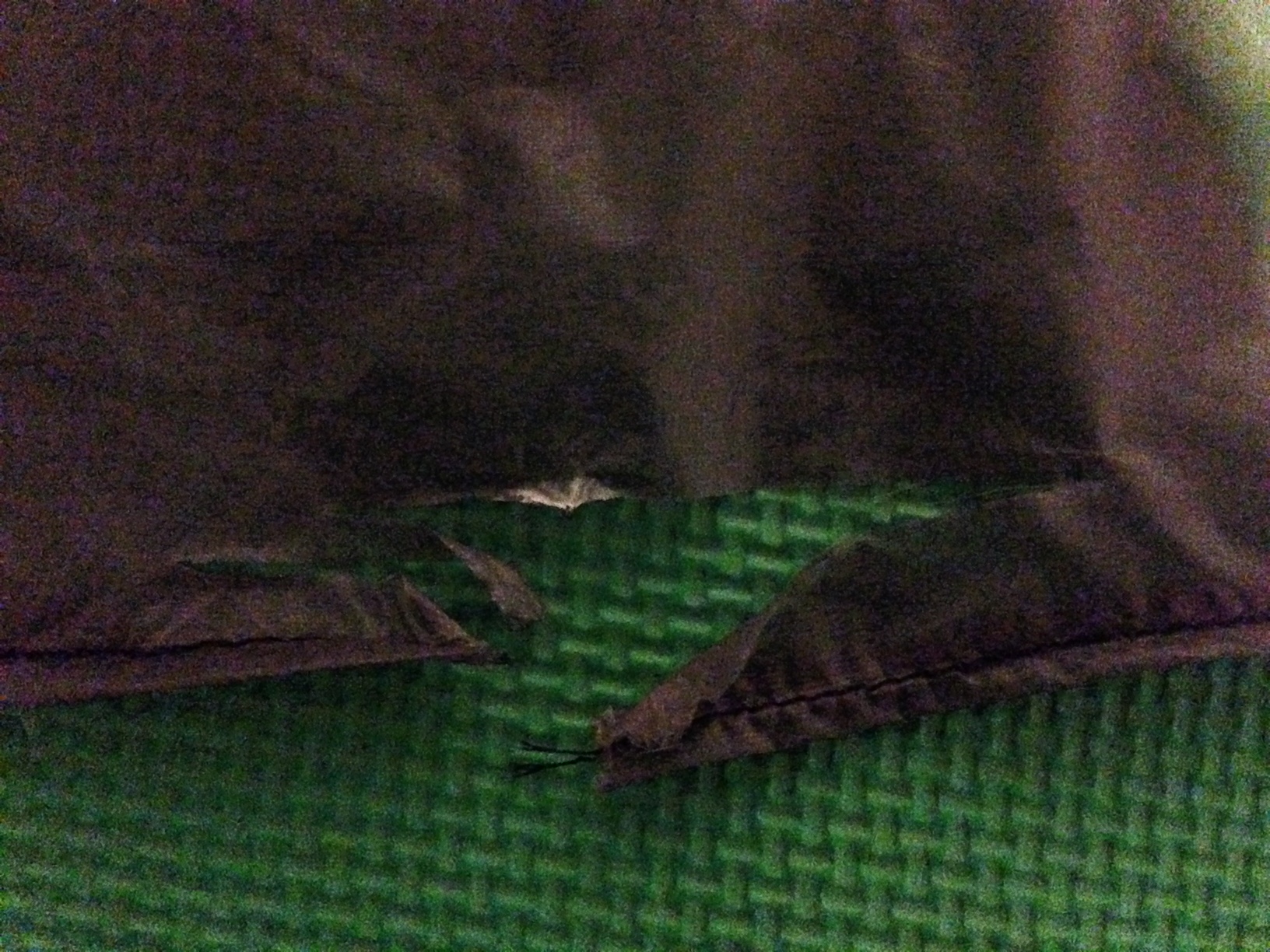Topic
0.7osy coated nylon
Forum Posting
A Membership is required to post in the forums. Login or become a member to post in the member forums!
Home › Forums › Gear Forums › Make Your Own Gear › 0.7osy coated nylon
- This topic has 44 replies, 20 voices, and was last updated 8 years, 9 months ago by
 Simon Kenton.
Simon Kenton.
-
AuthorPosts
-
Jan 2, 2016 at 5:36 pm #3373664
Well done, Aaron. Reminds me of a BT-2. I’ll anxiously be awaiting sag report. 4.4oz is ridiculously light. I wonder what a full mid would weigh. What is the height of it? Thanks for your efforts!
Found your build thread. Disregard.
https://backpackinglight.com/forums/topic/rockywoods-7d-coated-tarp-4-4-ounces/
Jan 10, 2016 at 11:09 am #3374895Thanks for posting about your shelter build, Aaron. Looks like a good design.
I made a rain kilt out of the 7D fabric this morning. Dimensions are mostly the same as my ULA rain kilt. Weight came out to be only 1.5oz. The fabric didn’t seem too fragile to me and it sewed up well, but I did have a hard time getting it to lay flat when cutting out the pattern. Part of that is probably because I’ve had the fabric stuffed into a ball since getting it a few weeks ago, but there’s also just not a lot of weight or natural stiffness to this stuff
Jan 10, 2016 at 6:38 pm #3375002Anonymous
Inactive@ John, to help with the issue you were talking about, use an iron on lowish heat setting, take a piece of parchment paper (inexpensive) larger than the iron and iron the material with the parchment paper on top of the fabric.
Then to cut the fabric, lay it out on a either a cutting mat or thin pine plywood board, and tack part of the outline of what shape you want to cut. Cut with a roller blade just outside the tack outline.
So far, this is the most effective way i’ve found to cut super thin/light and slipper fabrics. Until i came up with this method, it was bit of a hassle at times, especially when trying two fabrics on top of each other. With a single layer of fabric, you can use the iron method above and use some chalk to make the outline and then cut with scissors–that works fine with a single layer of fabric. I haven’t used chalk on silnylon so far, so i don’t know if it works with it or not, but i used it on fabrics with a DWR and technically these have a surface with a lower surface energy than the silicone coated fabrics so it should work.
Jan 10, 2016 at 7:08 pm #3375012Thanks for the tips, Justin. Maybe I should get a big piece of plywood. I’ve been using a large, unfolded cardboard box I got from UHaul. Getting the fabric to lay flat took more effort than normal, but I did eventually get it. Not a huge issue – just an observation that it was just more difficult compared to other fabrics I’ve used. For example, the Membrane Sil from RBTR lays flat really easily, and so does RTBR’s Membrane 10 quilt fabric
What else have people made with this 7D stuff so far?
Jan 11, 2016 at 4:25 pm #3375205I use 1/8″ x 4ft x 8 ft hardboard from HD to cut big pieces on. I have the 8 ft edges of 3 pieces taped together with duct tape so it folds out to a 8 ft x 12 ft cutting board.
Jan 11, 2016 at 5:14 pm #3375213I plan on using this material to add sod skirts to a Mid for cold weather use.
May 14, 2016 at 5:08 pm #3402450I just finished a 5×9 tarp with this. It weighs 4.32oz or 121 grams. I used 1/2″ grosgrain for the tieouts. I wish I would’ve used something wider as my x box stitches are sloppy at the corners. The fabric was too slippery. I didn’t use any reinforcement patches. I just rolled the hem over on itself 3 times. I tugged pretty hard on the fabric and it seems surprisingly sturdy. I’m going to slop some silnet on the tieouts then test them with some free weights hung over the back porch. I’d rather get as close as possible to failure without going over the edge. I think I will try two ten pound plates first. What max weight should I test to avoid failure? For example, what’s the highest likely real world weight that would be transferred to a tieout. I have 12 tieouts total.
Edit: I just revisited RJ’s article on inclement weather tarp camping technique, and he hypothesizes there that a 50mph wind could transfer 120lbs of force to a side of a tarp. If I were to encounter winds of that velocity (I won’t with this tarp) then I would pitch the tarp with the 9′ side to the ground. There would be 5 tieouts along the ground. Therefore each tieout should be able to withstand 24lbs, 30lbs for comfort. I think that the tieouts are strong enough for this but I will test them pre-silnet treatment to be sure.
2nd Edit – I just tested each corner tieout with 3 ten pound weights (30lbs.). Each tieout held easily with no visible stretching or tearing. I am now confident in this material for the conditions I expect to use it in. I still plan to add seam sealer to make up for my sloppy stitches. At some point I will make a solo sized pyramid with this material.
May 15, 2016 at 10:26 am #3402524Paul, thanks for sharing your tests with this fabric. What is your impression of the stretch of this material. If not too much trouble, could you take some pictures of your tarp pitched in half pyramid? (preferably under some mild winds).
May 15, 2016 at 12:12 pm #3402542It’s quite stretchy. I am interested in seeing how it performs when wet. I think it’ll be a saggy mess.
May 15, 2016 at 1:28 pm #3402555Now all you need is a “beak” at the front
Interesting how right at the mid tie-out it stretches outward so much. I’ve seen that too. With 1.4 osy silnylon.
May 15, 2016 at 1:43 pm #3402557I think that is a good observation to indicate how stretchy it is. I probably could slacken the front mid guyline and alleviate some of that stretch.
I don’t think I’ll add a beak. I like the simplicity of a flat tarp.
May 15, 2016 at 1:46 pm #3402559That’s one of my Don Quixote quests – to get people to put beaks on their half pyramids
Maybe I should have put a happy face or something
I have found that to work pretty good though. Often the wind will shift and start blowing rain inside. I guess it depends on the conditions you’ll be in.
May 15, 2016 at 2:14 pm #3402566I wonder if the coating can deal with the stretch.
I do not believe that this thin fabric is the right way for a shelter.May 15, 2016 at 2:34 pm #3402567Jerry said “Interesting how right at the mid tie-out it stretches outward so much. I’ve seen that too. With 1.4 osy silnylon.”
I think it has to do with the how differently the fabric stretches on the “bias” vs on the “warp / weft”. This issue gets magnified by the half pyramid pitch.Paul said “I don’t think I’ll add a beak. I like the simplicity of a flat tarp.”
A nice compromise would be to make a “curtain” (basically a trianglular piece you put in front of the open end) which gives you extra protection in bad weather. I have made a hoodless poncho (in which a sewn beak would have been impractical) and the “curtain” solution works well. Here some pictures showing the “curtain” used with a prototype for the tarp poncho I made out of 1.1 silnylon.
Curtain with 5’x9.5′ tarp (hoodless poncho) picthed in Half Pyramid mode
Here same tarp pitched in A-frame with “curtain” providing a bit more protection on one side. (Notice that here the ridge of the a-frame is along the “short side” of the 5″x9.5″ tarp. I found If I make the ridge on the long side it is too “claustrophobic”.
Looks like this 0.7oz material is a nice alternative providing both acceptable strength and aged waterproofness. Unfortunately I already finished my hoodless poncho out of silpoly 1.1oz PU4000, which has great aged HH but low tear strenght so I had to reinforce the tieouts (which increased the final weight on an already heavier tarp). Looks like with this 0.7 material that is not needed and a simple double rolled hem is good enough for the tieouts. On silpoly 1.1 PU 4000 an un-reinforced double rolled hem failed at 25lbs but per your own testings your tie-outs with 0.7oz silnylon were able to take 30 lbs without showing any sign of being near catastrophic failure.
May 15, 2016 at 7:21 pm #3402613 “per your own testings your tie-outs with 0.7oz silnylon were able to take 30 lbs without showing any sign of being near catastrophic failure.”
“per your own testings your tie-outs with 0.7oz silnylon were able to take 30 lbs without showing any sign of being near catastrophic failure.”I’m quite happy with the results. That was before treating with a seam sealer. Now that I have treated them, I am tempted to try another test at higher weight. Do you think the seam sealer would add an additional 5-10lbs of reinforcement?
Edit: Emboldened by the 30lb test result without a seam sealer. I attempted a 40lb test post-seam sealer treatment. On the first lift of 40lbs, the fabric and the pullout held. On my second attempt (with phone in hand for photo proof) the pull out tore from the fabric resulting in catastrophic failure.
May 15, 2016 at 8:03 pm #3402621Super helpful Paul. Looks like a small simple reinforcement patch in addition would push the tie out strength significantly. Personally I’d be happy with a couple of extra grams for that.
Anyone see any reason why I couldn’t bond this fabric with silicon, for reinforcement patches?
May 15, 2016 at 10:04 pm #3402640@ Paul. Oh man !!!!, sorry tarp is ruined. At least it didn’t happen out in the field thanks again for sharing your experience. I’m still wondering how much strength is really needed for the tieouts out in the field under normal conditions. I have ordered one of those handheld scales to take some measurements and will report back. In your picture is not 100% clear, but did the tear started at the stitchline of the hem?
@ Adam. I understand this 0.7oz silnylon has a PU coating in one side and a sil coating on the other side. I have been doing some testings with silpoly 1.1 oz PU 4000 which has the same type of hybrid coating and I have been using seamgrip (thinned with cotol for easier application / quicker curing time) to attach the reinforcement patches (on the PU coated side) with good results. I wonder which provides a better bond. Silicon glue on the sil side or seamgrip on the PU side.
May 15, 2016 at 10:46 pm #3402650Anybody know what 35 pounds would equate to in terms of wind speed?
May 15, 2016 at 11:54 pm #3402660Thanks Mario, that’s useful to know about the PU side. I guess I could do a test on both of I go the path of this fabric. I’m thinking of using it for a Poncho.
Aaron- I think I remember 30lbs being required for up to 50MPH winds on a tarp…hypothesised or calculated or maybe tested by Ryan Jordan in an article*??? But now I can’t find the exact info or that article. Will depend on a great multitude of factors of course…panel size, angle, fabric elasticity, number of guy outs, elasticity of guy line, possible elastic give in soil, relative load % of each guy out… I think if you had at least three guy outs on each side of an A frame, plus end ridge guys, and two trekking poles, I would expect that 30lbs would be enough for light-average winds (up to maybe 20MPH????). Hard to say. Given your tarp design with two pegs, there is potentially less load as its relatively low/ pyrimidal, but increased load because its only two pegs. I think the A frame trekking poles will transfer a lot of load to the ground through that triangle (thus less load on the pegs) and importantly this is where the shelter is highest and more exposed to the wind, though that mainly works for cross winds. Depending on how you built it, your rear guy out might be quite strong if there is a rolled seam down the back ridge that connects right into your grossgrain (or whatever you used).
Personally I think 30lbs is the dirt minimum I would personally be happy with on any tarp or tent.
*Edit: realised why I can’t access the article…I can’t access stuff all…seems my Lifetime membership on here is no more. Yay.
***Large amount of speculation on my part***
May 18, 2016 at 6:45 am #3403172“@ Paul. Oh man !!!!, sorry tarp is ruined. At least it didn’t happen out in the field thanks again for sharing your experience. I’m still wondering how much strength is really needed for the tieouts out in the field under normal conditions. I have ordered one of those handheld scales to take some measurements and will report back. In your picture is not 100% clear, but did the tear started at the stitchline of the hem?”
I wish I could’ve better observed where the tear did start. I believe it started at the tieout and not the hem, but that is just idle conjecture.
No worries that it’s ruined :)
I’d rather the community have some good info then have it fail in the field, like you said.
Plus, my wife has been wanting me to make her a rain kilt. This material will be perfect for that.
-
AuthorPosts
- You must be logged in to reply to this topic.
Forum Posting
A Membership is required to post in the forums. Login or become a member to post in the member forums!
Trail Days Online! 2025 is this week:
Thursday, February 27 through Saturday, March 1 - Registration is Free.
Our Community Posts are Moderated
Backpacking Light community posts are moderated and here to foster helpful and positive discussions about lightweight backpacking. Please be mindful of our values and boundaries and review our Community Guidelines prior to posting.
Get the Newsletter
Gear Research & Discovery Tools
- Browse our curated Gear Shop
- See the latest Gear Deals and Sales
- Our Recommendations
- Search for Gear on Sale with the Gear Finder
- Used Gear Swap
- Member Gear Reviews and BPL Gear Review Articles
- Browse by Gear Type or Brand.



 “per your own testings your tie-outs with 0.7oz silnylon were able to take 30 lbs without showing any sign of being near catastrophic failure.”
“per your own testings your tie-outs with 0.7oz silnylon were able to take 30 lbs without showing any sign of being near catastrophic failure.”

